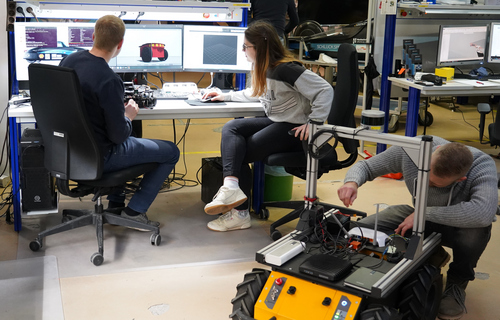Labor Autonome Mobile Systeme
Autonome mobile Systeme
Profile and objectives
Mobile autonomous systems are already an established part of our everyday lives, think of vacuum cleaners, lawn mowers or automated logistics systems. Developments in automated driving, the continuous digitalization of production, the need for availability of real-time environmental data, or increasing demand for support in nursing care, to give but a few examples, will cause the number of mobile robots around us to keep rising sharply.
A central issue for the systems is the processing of internal and external sensor data and, derived from this, the control of the actuators, which ultimately allows the autonomy of the systems. The design, implementation and system integration of these complex control algorithms requires powerful simulation and design tools as well as experience in system composition and tuning.
The Mobile Autonomous Systems Lab introduces students to the challenges of autonomous mobile systems and presents solution methods and system components for a variety of different problems in simulation and system integration.
Internships and Tutorials
In the Lab, students are given the opportunity to program mobile robot systems. Different approaches to programming and simulation of robots are demonstrated using moving and flying systems.
The topics of the Lab are presented in the form of short lecture blocks and practical experiments:
- Software components for sensors, actuators and planning
- Robot Operation System (ROS) as robotic middleware
- Simulation with Gazebo and Simulink
- Sensors, mapping and path planning
The hardware equipment includes various robotic platforms, such as the Turtlebot3 and a Clearpath Husky robot, as well as several small quadrocopters from the Micro Aerial Vehicles (MAV) and medium size range. The lab computers with Windows and, in particular, Linux operating systems allow flexible testing of developed algorithms.
The Lab also offers a variety of tasks for Bachelor’s and Master’s theses (at the University and in cooperation with industrial companies).
